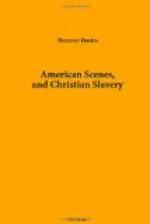Behind this range of buildings is another, a more modern and more imposing pile. This extends in front 151 feet, is built of red sandstone, is in the Gothic style, and contains the libraries of the institution. The central building, called the College Hall, containing the College Library properly so called, measures in front 51 feet, and in depth from front to rear 95 feet, having at each corner a tower of the extreme height of 91 feet. The interior is one room, whose measurement is 83 feet by 41, resembling in form a Gothic chapel, with its nave and aisles. The nave is 51 feet high, and its breadth 17 feet. Between its clustered pillars on either side are alcoves, each 10 feet by 12, fitted up with shelves for books. The number of volumes it now contains is about 20,000. The extreme wings and the connecting wings on either side are very elegant, and fitted up for various libraries connected with the institution, such as the Students’ Library, the Reading Room, the Calliopean Library, and the Livonian Library. The Students’ Library contains 9,000 volumes. This beautiful range of buildings probably contains not fewer than 40,000 volumes; and ere long the number will be doubled! Little did the ten ministers who, in 1700, met together to establish this seminary, each laying down his donation of books with these words, “I give these books for the founding of a college in this colony,” and who found that their joint-contribution amounted to only forty volumes,—little did they think what that small beginning would come to!
You are looking out for literary curiosities. Here is one—Elliot’s Indian Bible! You have heard of Elliot, “the Apostle of the North American Indians.” Here is a translation of the entire sacred volume into one of the languages of those people. The New Testament was published in 1661, and the Old Testament in 1663. The book before us is a copy of the second edition of the New Testament in 1680, and of the Old Testament in 1685. But where are those Indians, or their descendants? They are extinct; and there is not now a man on the whole continent of America that speaks their language!
Time will not permit me to describe the Picture Gallery, the Anatomical Museum, the Cabinet of the Materia Medica, the Museum of Natural History, and many other objects of interest. You must, however, take a peep at the Mineral Cabinet, or Geological Museum. It has been collected and arranged, with great industry and taste, by Professor Silliman. Look at this meteoric iron-stone. It fell a few years ago in Texas, and weighs 1,635 lbs.!
Our guide, Mr. Dutton, insists upon our calling at the college-room of Dr. Goodrich, one of the Theological Professors. We do so; and find him engaged in revising Webster’s Large Dictionary, about a dozen volumes, for a new edition. But what a polite man! Talk of American rudeness! A reception more kind and courteous than this you have never received from any man.




